Ever since I had my first bite of Korean BBQ, I’ve been obsessed with Korean food. But one dish truly captured my interest (and stomach) Kimchi.
This spicy and probiotic-rich side dish is not just a condiment. It’s an experience!

Today, I will share my favorite recipe for Korean Napa Cabbage Kimchi.
It’s easy enough for beginners but delivers authentic, restaurant-quality flavors.
So, grab a napa cabbage, get ready to get your hands a little spicy, and let’s embark on this delicious journey together!”
Other Recipes You Might Like
Understanding Kimchi: A Korean Culinary Staple
Let’s talk about Kimchi! If you’ve been a fan of Korean cuisine, you’ve probably encountered this famous fermented side dish.
Korean Napa Cabbage Kimchi, the most common variety, is a treat for the taste buds. It’s spicy, tangy, and bursting with umami – a flavor bomb that complements any Korean meal perfectly.
But Korean Napa Cabbage Kimchi is more than just delicious. It’s a cultural touchstone, a testament to Korean ingenuity, and a symbol of family tradition. Growing up, my grandma used to spend hours making giant batches of kimchi during the fall – a process known as “kimjang”
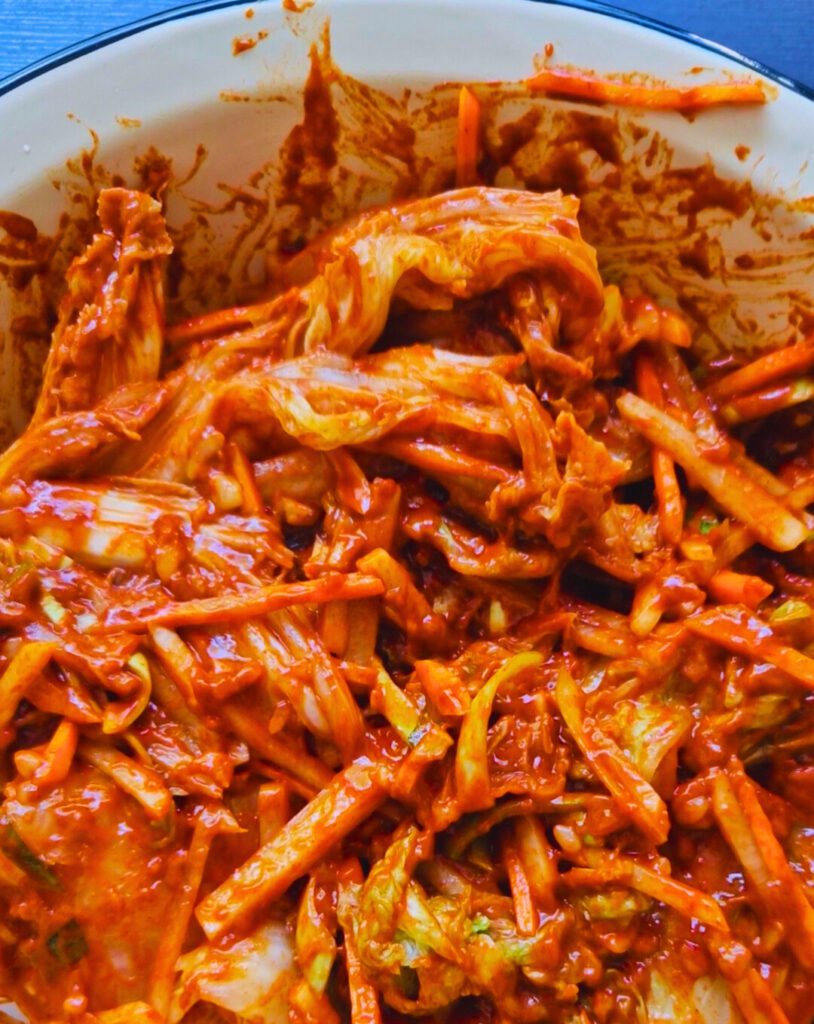
The whole family would gather, chopping vegetables, mixing spices, and filling massive earthenware jars with the vibrant red mixture. It was a time of laughter, stories, and the delicious promise of kimchi for months to come.
Korean Napa Cabbage Kimchi’s story goes way back, possibly even 4,000 years Back then, it was a way to preserve vegetables during harsh winters.
The fermentation process, fueled by good ol’ bacteria (Lactobacillus, to be specific not only extended shelf life but also created a treasure trove of health benefits.
The beauty of Korean Napa Cabbage Kimchi lies in its diversity. There are literally hundreds of regional variations, each with its own unique twist
Some kimchi is milder, some are packed with seafood, and some even incorporate fruits!
Key Ingredients for Kimchi
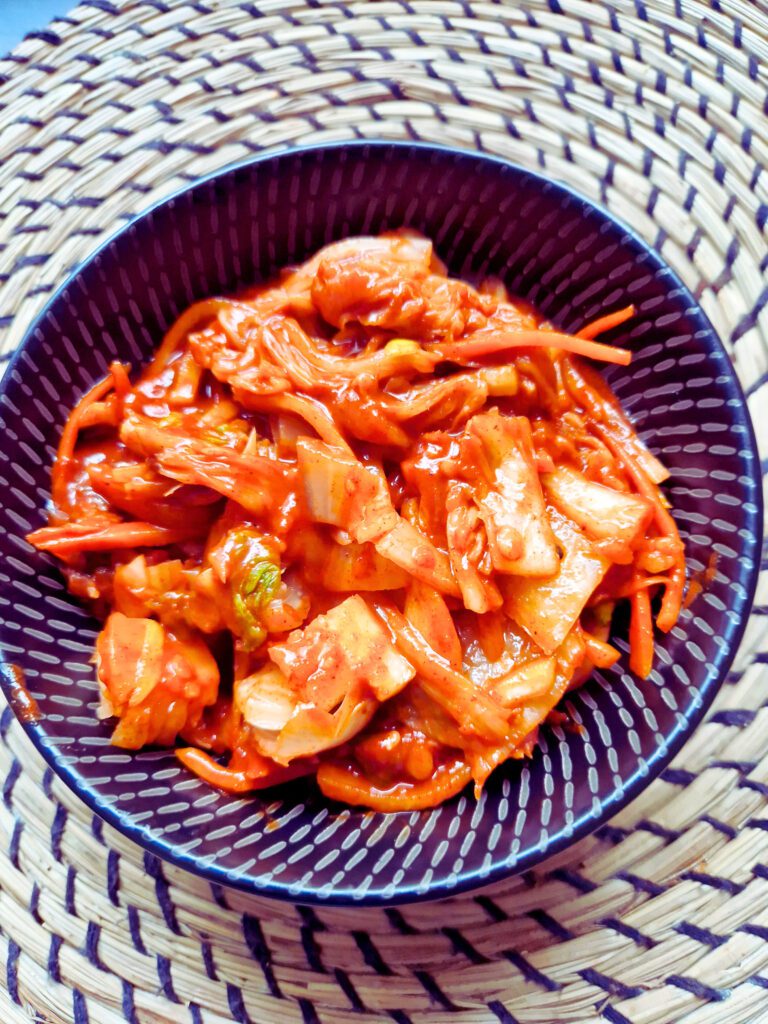
Let’s get down to brass tacks – what makes Korean Napa Cabbage Kimchi so darn delicious? It all boils down to carefully selected ingredients, each vital in creating that symphony of flavor and texture.
The fiery heart of Korean Napa Cabbage Kimchi comes from gochugaru, a Korean chili pepper flake. Its vibrant red hue and varying degrees of heat (depending on the variety) give kimchi its signature kick.
Remember my grandma’s kimchi-making sessions? The discussions about how much gochugaru to add were legendary! It was a delicate balance between fiery satisfaction and tear-inducing inferno.
Sea Salt and Fish Sauce
Korean coarse sea salt is another crucial ingredient. It draws out moisture from the napa cabbage, prepping it for fermentation, and also contributes to the complex salty depth of kimchi
Fish sauce, another common addition, adds a layer of umami that rounds out the overall flavor profile
Garlic, Ginger, and Shrimp
Fermentation is what gives Korean Napa Cabbage Kimchi its characteristic funky tang. To kickstart this process, a generous number of garlic and ginger is added
These aromatics add depth and contribute to the kimchi’s health benefits. Some recipes incorporate salted shrimp (saeujeot) for an extra punch of umami and that signature funky character.
Sugar and Pear
A touch of sweetness is often included in Korean Napa Cabbage Kimchi to balance the spice and saltiness. Sugar can come in various forms, from white sugar to Korean rice syrup
But a secret weapon in some recipes is the humble Asian pear. Chopped pear adds a touch of natural sweetness and a subtle fruitiness that elevates the kimchi to new heights.
A Step-by-Step Preparation for Kimchi
Ready to embark on your own kimchi-making adventure? Buckle up, because I’m about to guide you through the exciting (and slightly messy) process of creating your very own batch of Korean Napa Cabbage Kimchi.

Gather Your Ingredients:
Here’s what you’ll need to create your own kimchi:
- A large napa cabbage (around 5-6 lbs)
- Coarse sea salt
- Gochugaru (Korean chili flakes) – adjust the amount based on your desired spice level!
- Garlic, minced
- ginger, minced
- 2 scallions
- 1 medium white onion, minced
- Fish sauce (optional, but adds a wonderful depth of flavor)
- Sugar (white sugar or Korean rice syrup)
- Shrimp paste or salted shrimp (saeujeot) – for that extra funky kick (also optional)
- Optional extras: carrots, white radish, or Asian pears for added texture and sweetness
Step 1: Prepping the Cabbage
The first step involves prepping the show’s star – the napa cabbage. Cut it in half lengthwise, then cut each half again.
Now comes the salting. Generously sprinkle coarse sea salt between the leaves, making sure to get in all the nooks and crannies.
Trust me, don’t be shy with the salt – this process helps draw out moisture and prepare the cabbage for fermentation.
Let the salted cabbage sit in a large bowl for a few hours, weighted down with a plate or something heavy. You’ll see the cabbage releasing water – that’s a good thing!
After a few hours, rinse the cabbage thoroughly under cold water to remove the excess salt.
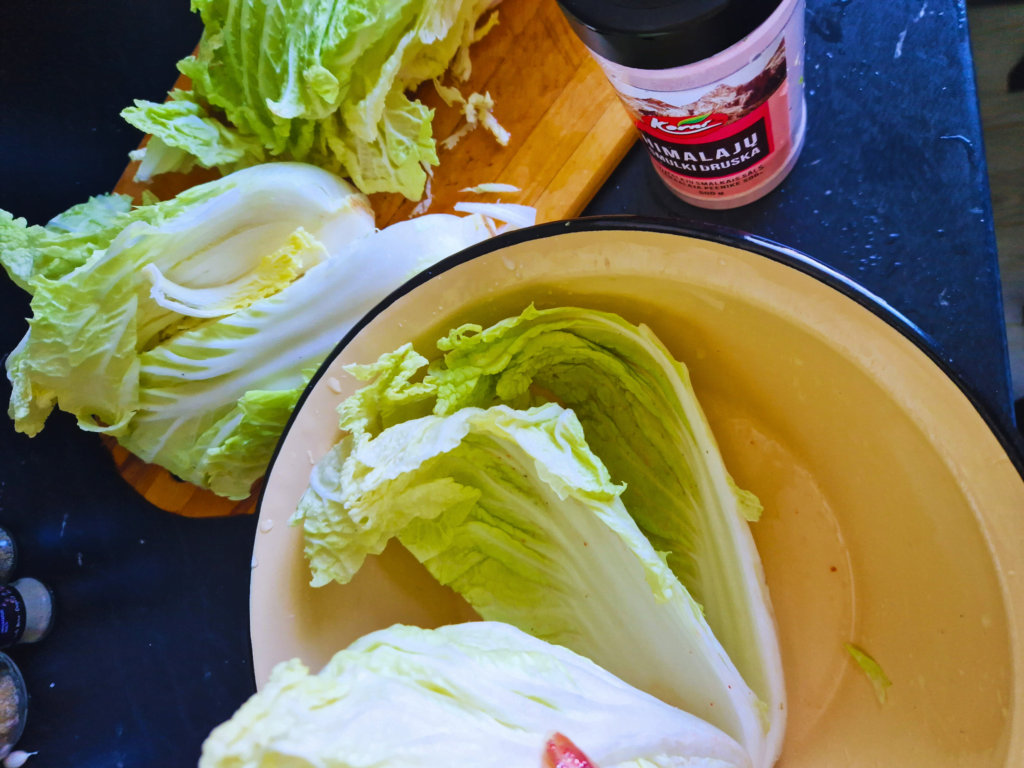
Step 2: Making the Kimchi Paste
While the cabbage is taking a salt bath, we can whip up the kimchi paste – the flavor powerhouse of this dish. Here’s where things get exciting (and maybe a little spicy!).
In a blender or food processor, combine gochugaru, chopped garlic, ginger, and scallions. Blend it into a vibrant red paste.
Now, add some sugar to balance the spice, and for an extra umami punch, throw in some fish sauce and/or shrimp paste (be warned, shrimp paste has a strong flavor, so start slowing!).
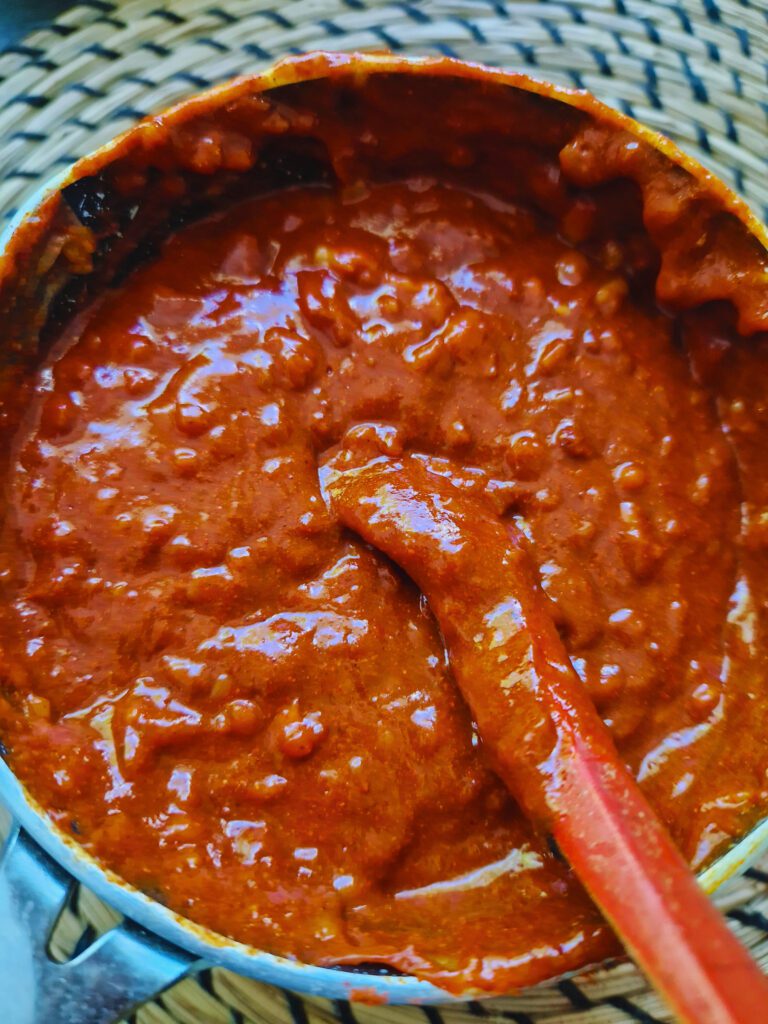
Step 3: Mixing and Marinating
Here comes the fun part – getting your hands dirty!
Combine the rinsed and drained cabbage in a large bowl with the kimchi paste. Get in there and massage the paste into the cabbage leaves, ensuring everything gets evenly coated.
Once everything is well mixed, pack the kimchi mixture tightly into a non-reactive container (glass jars are perfect).
Press down to remove air pockets – kimchi needs an anaerobic environment to ferment correctly.
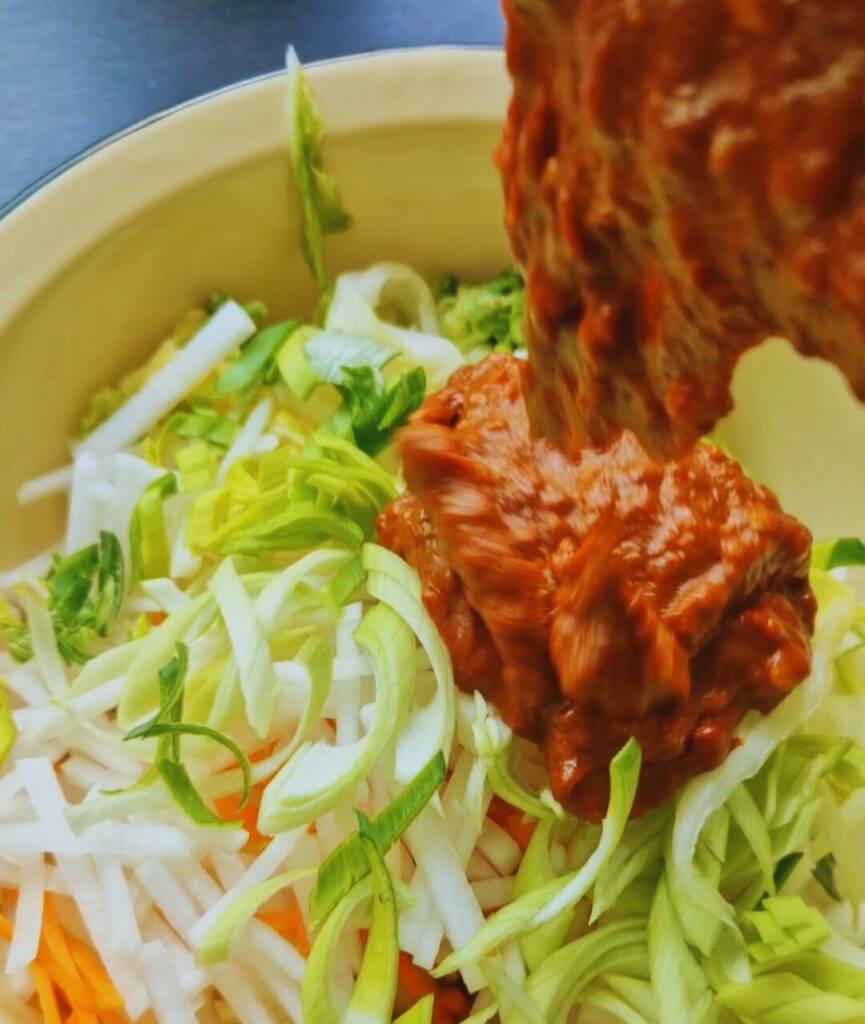
Step 4: Fermentation
Now comes the waiting game – the fermentation process. Leave your kimchi container at room temperature for 1-3 days.
The kimchi will bubble and fizz as the good bacteria work their magic during this time. You must “burp” your container daily by releasing the built-up pressure.
You can do this by opening the lid for a few seconds and then sealing it tightly.
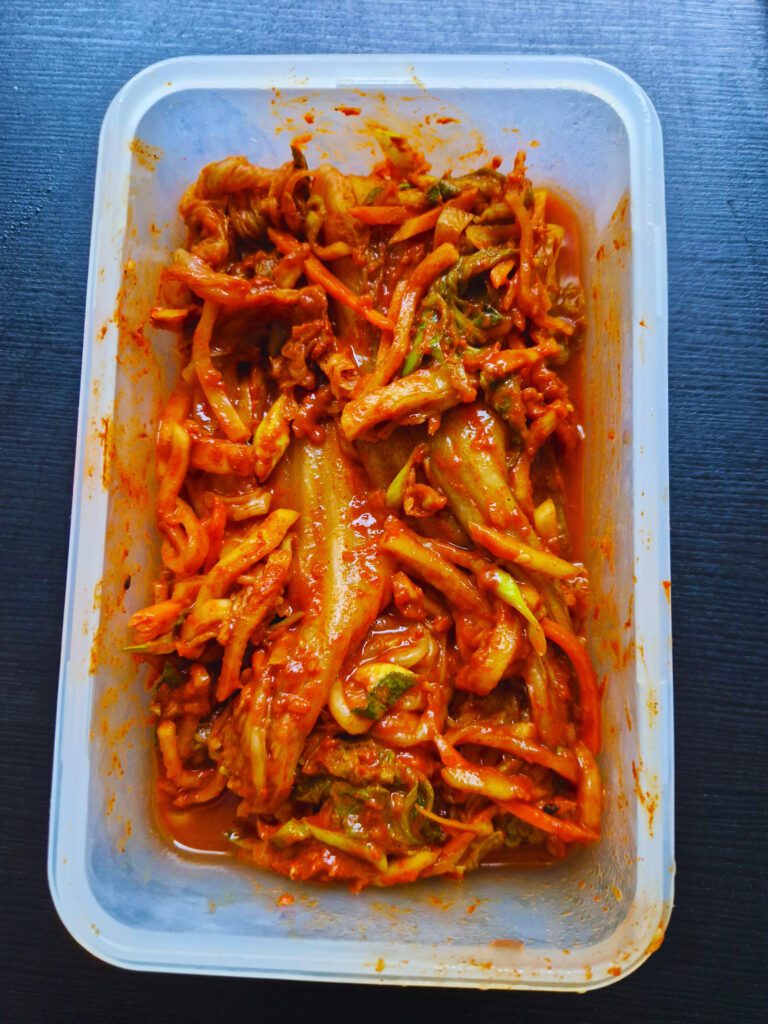
Step 5: Kimchi Time!
After a few days of fermentation at room temperature, your kimchi should be bubbling and have a pleasantly tangy aroma. Taste it!
The flavor will continue to develop as it ferments, so adjust the waiting time based on your preference. Transfer your kimchi to the refrigerator once you’re happy with the taste.
It will continue to mature and ferment slowly in the cold, but the cool temperature will slow down the process significantly.

Storing and Serving Kimchi
Chilling is Key
Remember that kimchi is a fermented food; like all fermented things, it thrives in a cool environment. Your refrigerator is the perfect place to store your kimchi masterpiece.
The cold temperature slows down the fermentation process significantly, allowing you to enjoy your kimchi for weeks, even months.
Farewell, Funky Fridge:
One thing to keep in mind – kimchi can be a bit… aromatic. That wonderful funky scent we love so much can permeate your entire fridge.
Invest in a good quality, airtight container for your kimchi to avoid an olfactory overload. Glass jars with tight-fitting lids are ideal.
The Art of the Scoop:
Here’s a crucial tip for kimchi aficionados: always use a clean utensil to scoop out your kimchi. Dipping your greasy chopsticks or a dirty spoon into the jar is a surefire way to introduce unwanted bacteria that can accelerate spoilage.
Trust me, nobody wants a mushy, off-flavored kimchi situation.
So, there you have it!
With this storage and serving tips, you can ensure your Korean Napa Cabbage Kimchi stays fresh, flavorful, and ready to brighten up your meals for weeks to come.
Now go forth, kimchi champion, and enjoy the delicious rewards of your fermentation journey!
Health Benefits of Napa Cabbage Kimchi
Let’s talk about kimchi beyond its addictive flavor profile. Korean Napa Cabbage Kimchi, this spicy, fermented wonder, isn’t just a culinary delight – it’s a powerhouse of potential health benefits!
- Probiotic Powerhouse The fermentation process that gives Korean Napa Cabbage Kimchi its signature tang is also responsible for one of its biggest health benefits – probiotics These live microorganisms are like tiny gut heroes, promoting a healthy digestive system and potentially boosting your immune functionAfter all, a happy gut is a healthy gut, and kimchi might just be the key to achieving that.
- Weight Management Warrior?Some studies suggest that kimchi might play a role in weight management The probiotics in kimchi may help regulate your metabolism and potentially aid in weight loss effortsNow, kimchi shouldn’t be your sole weight-loss strategy, but including this flavorful fermented friend in your diet certainly doesn’t hurt.
- A Boost for Your Immune SystemRemember how I mentioned kimchi’s potential immune-boosting properties?Well, research suggests that the probiotics and other beneficial compounds in kimchi might contribute to a stronger immune system, helping your body fight off illness While kimchi isn’t a magic bullet, it can be a delicious way to support your overall health and well-being.
- Antioxidant All-StarKorean Napa Cabbage Kimchi is packed with antioxidants, those warrior molecules that fight free radicals in your body [7]. Free radicals can contribute to cell damage and various chronic diseases. By incorporating antioxidant-rich kimchi into your diet, you might be giving your body a helping hand in staying healthy.
- A Heart-Healthy Habit?Early research suggests that kimchi consumption might have some heart-health benefits [8]. The probiotics and other bioactive compounds in kimchi may help lower cholesterol levels and improve blood pressure [9]. Of course, consult your doctor before making any drastic dietary changes, but kimchi can be a delicious way to support a heart-healthy lifestyle.
- Remember, Moderation is KeyWhile kimchi boasts a wealth of potential health benefits, moderation is always key. Kimchi can be high in sodium, so enjoy it in reasonable portions as part of a balanced diet.
- Kimchi: A Delicious and Functional FoodSo, the next time you reach for a bite of Korean Napa Cabbage Kimchi, remember that you’re not just indulging in a flavorful side dish – you’re potentially doing your body a favor!It’s a delicious way to add probiotics, antioxidants, and other beneficial nutrients to your diet.
Conclusion: Embrace the Flavor of Homemade Kimchi
Dive into the world of Korean Napa Cabbage Kimchi!
Make your own batch, savor the delicious results, and experience a taste of Korean tradition. It’s a fun and rewarding journey, so grab your ingredients and kimchi-fly your world!
What ingredients are used to make kimchi?
Kimchi is made from napa cabbage salted to soften it, then mixed with garlic, ginger, chili flakes, green onion, and fermented seafood paste (like fish sauce). It’s packed and left to ferment.
Is kimchi good for your health?
Yes. Kimchi is rich in probiotics, vitamins, antioxidants, and fiber. These support digestion, gut health, and overall immunity.
Why do some people get stomach discomfort from kimchi?
Fermented foods introduce active bacteria into the gut. If your digestive system isn’t used to probiotics, you may feel gassy or bloated at first — this usually improves over time.
How would you describe the taste of kimchi?
Kimchi is tangy, salty, spicy, slightly sour, and has a gentle fermented funk similar to pickles or sauerkraut but with chili and garlic warmth.

Easy Kimchi at Home (Tongbaechu-Kimchi!)
Ingredients
Method
- The first step involves prepping the show's star – the napa cabbage. Cut it in half lengthwise, then cut each half again. Now comes the salting. Generously sprinkle coarse sea salt between the leaves, making sure to get in all the nooks and crannies. Trust me, don't be shy with the salt – this process helps draw out moisture and prepare the cabbage for fermentation.Let the salted cabbage sit in a large bowl for a few hours, weighted down with a plate or something heavy. You'll see the cabbage releasing water – that's a good thing! After a few hours, rinse the cabbage thoroughly under cold water to remove the excess salt.
- While the cabbage is taking a salt bath, we can whip up the kimchi paste – the flavor powerhouse of this dish. Here's where things get exciting (and maybe a little spicy!).In a blender or food processor, combine gochugaru, chopped garlic, ginger, and scallions. Blend it into a vibrant red paste. Now, add some sugar to balance the spice, and for an extra umami punch, throw in some fish sauce and/or shrimp paste (be warned, shrimp paste has a strong flavor, so start slowing!).
- Here comes the fun part – getting your hands dirty! Combine the rinsed and drained cabbage in a large bowl with the kimchi paste. Get in there and massage the paste into the cabbage leaves, ensuring everything gets evenly coated.Once everything is well mixed, pack the kimchi mixture tightly into a non-reactive container (glass jars are perfect). Press down to remove air pockets – kimchi needs an anaerobic environment to ferment correctly.
- Now comes the waiting game – the fermentation process. Leave your kimchi container at room temperature for 1-3 days. The kimchi will bubble and fizz as the good bacteria work their magic during this time. You must "burp" your container daily by releasing the built-up pressure. You can do this by opening the lid for a few seconds and then sealing it tightly.
- After a few days of fermentation at room temperature, your kimchi should be bubbling and have a pleasantly tangy aroma. Taste it! The flavor will continue to develop as it ferments, so adjust the waiting time based on your preference. Transfer your kimchi to the refrigerator once you're happy with the taste. It will continue to mature and ferment slowly in the cold, but the cool temperature will slow down the process significantly.




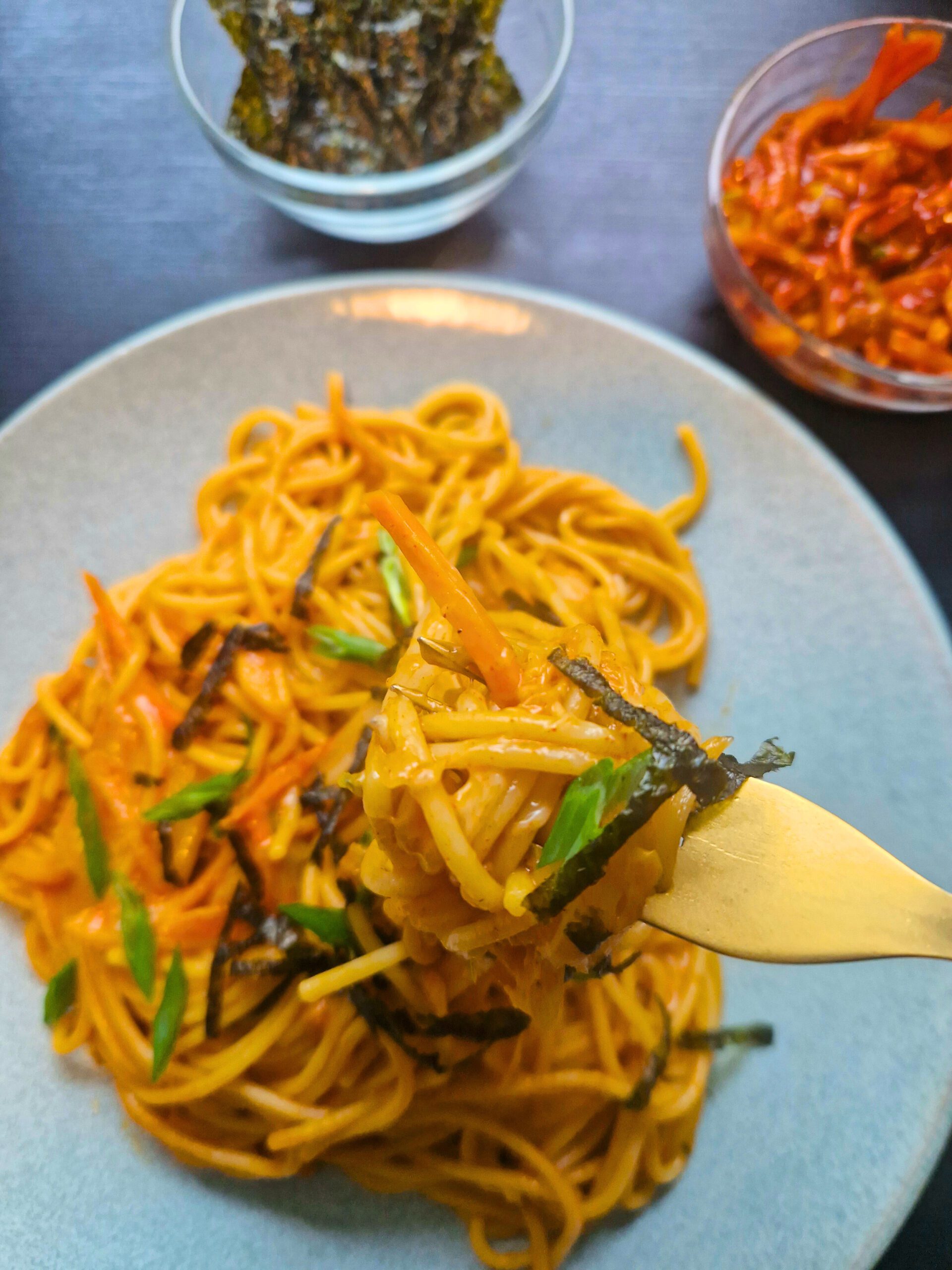
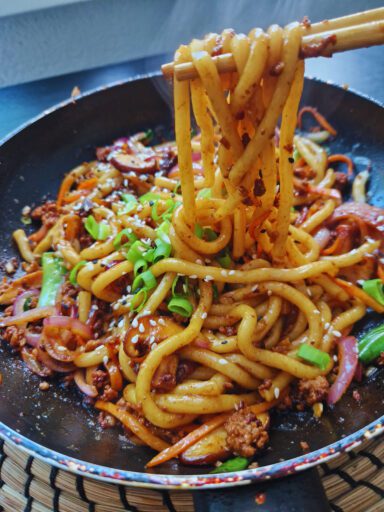
[…] IS KIMCHI RECIPE YOU MIGHT […]
Gonna try it in my kitchen!
Sounds good! Let me know if you need any help or have any questions.
That’s exciting-your kitchen is about to smell amazing.